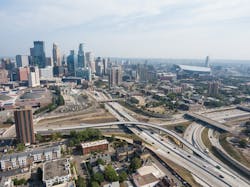NO. 3 ROAD: The Busiest Intersection in Minnesota
The 35@94: Downtown to Crosstown project was huge, and had to be constructed in five stages in Minneapolis, Minnesota. The project included additional lane capacity, new traffic movements at the merge of Interstate 35W and 94, a rehabilitated roadway, 17 new bridges, a new ramp into the Lake Street Business district, a new transit station, new E-ZPass lanes, elements to increase access for pedestrians, and an extensive eight-block reconstruction of the highly urban area of Lake Street.
There was meticulous planning involved considering the amount of work that had to be done on this project. It began in 2013 when the Minnesota Department of Transportation estimated roughly 200,000 vehicles on I-35W and 243,000 vehicles on I-94 daily, and determined to reconstruct the “busiest intersection in the state”, the project team had to develop a five-stage process to keep traffic flowing safely. Although a constant challenge in the project, crews looked for opportunities to build out of sequence, and performed temporary work to switch traffic patterns to allow access to work earlier, pushing the project forward.
Jason Block, the operations manager at Ames Construction, Inc. talked about the challenges the crew faced with the project, stating, “for the 35W@94 project to be considered a success, it was paramount that we deliver a safe, quality project, on budget, while meeting or exceeding all interim and substantial milestones. Within that goal, maintenance of traffic through this busy interchange was the priority, along with ensuring safe access for pedestrians, neighboring residents and businesses, and other community stakeholders. We constantly reviewed and altered traffic control and staging to alleviate the burden on the public as much as possible and identify opportunities to build out of sequence that would allow us access to work earlier and push the project forward."
The site of the project had complex issues, such as demolishing a bridge, which required the closure of I-35W ten times over weekends. The site had a deep water main and sanitary sewer utilities crossing the highway which required crews to excavate as deep as 30 feet to lay across the highway. Retaining walls also required deep excavation as crews contended with existing utilities, some of which were 100-year-old water and sewer infrastructure.
Safety was a top priority, and specific safety strategies had to be utilized, including assigning a full-time safety manager who was always on site. Emergency responders had to be present whenever traffic patterns changed to review routes, detours, and durations. A traffic safety engineer had to drive the site regularly to ensure the safety of traffic patterns and road configurations.
Road projects must look at the impact it will have in the community it’s in. This project prioritized temporary pedestrian access routes (TPAR) to ensure pedestrians had safe access to businesses in the area. The project, luckily, provided safer and better pedestrian routes, such as some of the old pedestrian bridges over I-35W lacking ramps, being inaccessible for those who cannot climb stairs. The new bridge has walkways, bike paths, and ramps to improve access for all forms of transit.
A full-time erosion control crew was responsible for maintaining the National Pollutant Discharge Elimination System (NPDES) permit and stormwater pollution prevention plan (PSWPPP) requirements. The crew had to perform corrective action tasks identified on Erosion Control Site Investigations. Any issues identified were addressed by the erosion control crew and reviewed at the walk-through the following week. The efforts put forth by the crew resulted in the project meeting its environmental goals for erosion control.
In order to minimize any disruptions to the community, night construction was limited to four nights a week in any location, and vibration monitoring was conducted in order to protect building and home foundations. There was additional neighborhood outreach protocols, such as a hotline for concern, project information, and updates that were in multiple languages. Lastly, pop-up events for residents to express their concerns or learn more about the project were provided. R&B
Project: 35W @ 94: Downtown to Crosstown
Location: Minneapolis, Minnesota
Owners: Minnesota Department of Transportation
Designer: Minnesota Department of Transportation
Contractor: ALS Joint Venture (Ames Construction Inc.; Lunda Construction Co.; Shafer Contracting Co.)
Cost: $240 million
Length: 2.5 miles
Completion Date: September 2021
